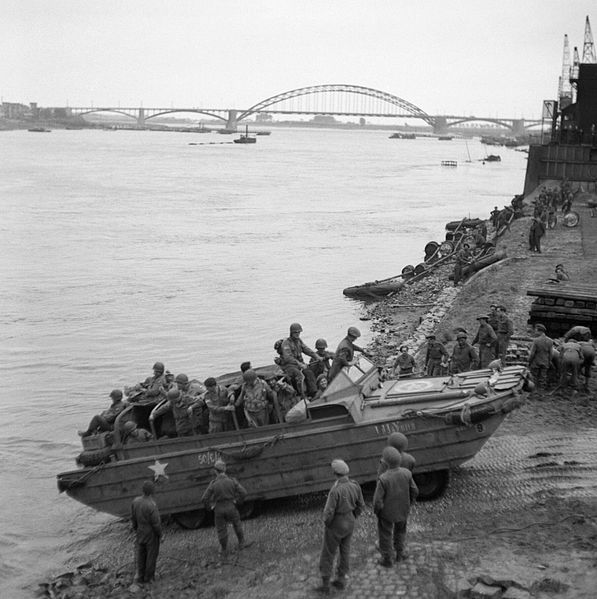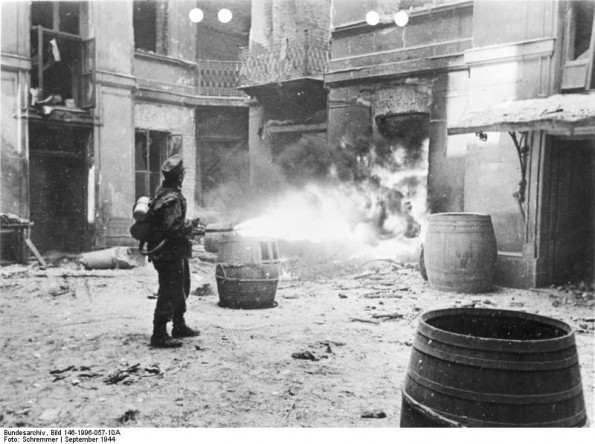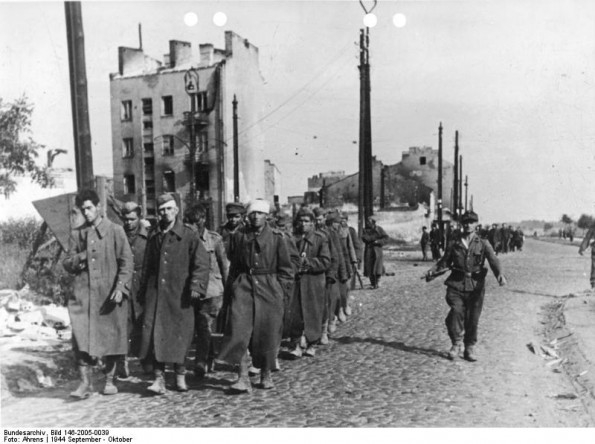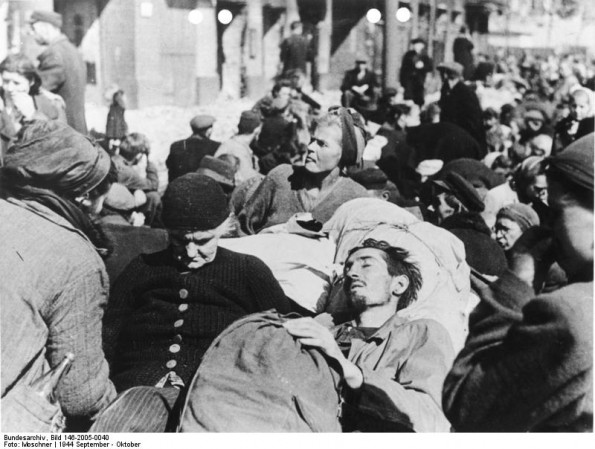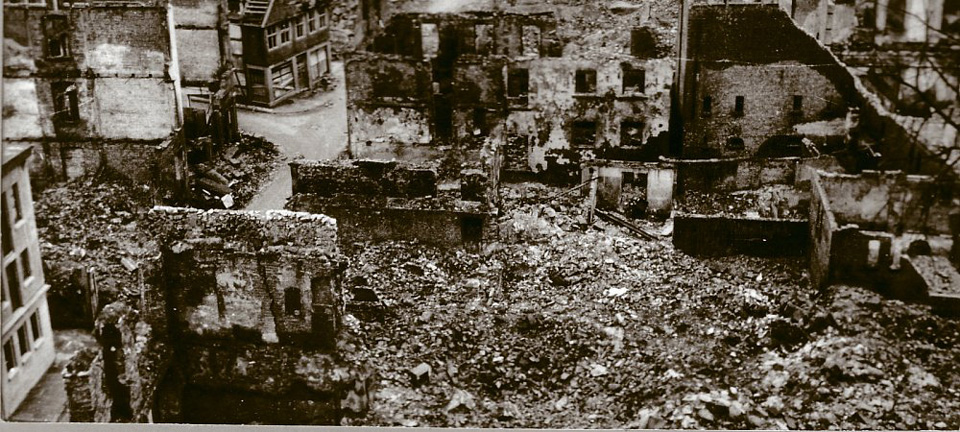Air Operations, Carolines
20 VMF-114 F4U dive-bombers attack front-line Japanese Army ground positions on Peleliu with 1,000-pound bombs at 0700 hours. 14 of the bombs strike an area only 100 yards square.
[Air Operations, CBI
BURMA- 11 10th Air Force B-25s attack the main bridge and two bypass bridges at Hsenwi.
- More than 50 10th Air Force P-47s attack the airfields at Anisakan and Nawnghkio, a rail bridge at Nansiaung, the Bhamo and Myothit areas, and targets of opportunity at Khalayang and along the Burma Road between Bhamo and Mangshih, China.
- 29 308th Heavy Bomb Group B-24s and 12 341st Medium Bomb Group B-25s attack the Tienho and White Cloud airfields at Canton and Wuchou.
- 6B-25s attack targets of opportunity near Lungfukwan.
- 14th Air Force fighter-bombers mount nearly 100 effective sorties against river shipping and targets of opportunity along and south of the Yangtze River.
- 18 7th Heavy Bomb Group B-24s transport fuel from India to three locations in China.
Air Operations, Central Pacific
During the night, VII Bomber Command B-24s based at Kwajalein attack Wake Island.
[Air Operations, East Indies
- In one of the Pacific War’s longest missions, 70 5th, 307th, and 90th Heavy Bomb group B-24s based at or staging through the Kornasoren airfield on Noemfoor attack oil installations at Balikpapan, Borneo.
- 4 B-24s are lost.
- V Bomber Command B-24s attack the Ambesia airfield on Celebes.
- FEAF B-25s attack Langoan (Celebes), Mapanget (Celebes), Sidate (Celebes), and shipping off Halmahera.
- FEAF P-38s attack shipping in Wasile Bay in the Molucca Island, the seaplane base at Halong (Celebes), and the airfields on Ceram.
- 347th Fighter Group P-38s down 1 Ki-49 'Helen' heavy bomber and 2 Ki-43 'Oscar' fighters over Celebes at 0920 hours.
Air Operations, Europe
RAF BOMBER COMMANDDaylight Ops:
- 139 aircraft of Nos. 4 and 8 Groups are sent to attack the oil facility at Sterkrade. In the aircraft total are 108 Halifaxes, 21 Lancasters and 10 Mosquitos. The target is covered in cloud and only 24 attack the main target while the other bomb the general area of the town of Sterkrade.
- 1 Halifax is lost.
- 101 Halfaxes, 25 Lancasters and 10 Mosquitos of Nos. 6 and 8 Groups also encounter heavy cloud at Bottrop. Only 1 aircraft attempts to bomb the oil pland while the rest bomb the estimated positions of various Ruhr cities.
- There are no losses.
- 6 Hudsons are on Resistance operations, 74 Halifaxes are on fuel-carrying flights and there are 2 Ranger patrols and 3 RCM sorties. The 2 Ranger aircraft, of No. 515 Squadron and having flown from a forward airfield in France, are both lost as they are force-landed in Switzerland.
Minor Ops
- 46 Mosquitos are sent to Hamburg, 6 each to Aschaffenburg and Heilbronn, and 5 to Sterkrade, there are 14 aircraft on Resistance operations and there are 20 Mosquito patrols and 1 RCM sortie.
- 1 Mosquito of No. 100 Group is lost.
ETO:
- More than 100 8th Air Force B-24s transport fuel to Allied bases in France and Belgium.
- Only 37 1st Bomb Division B-17s attack their briefed primary tarts, the Munster/Handorf Airdrome and a marshalling yard at Munster.
- 239 1st Bomb Division B-17s attack the city of Munster (a target of opportunity).
- 206 2nd Bomb Division B-24s attack a marshalling yard at Hamm.
- 12 2nd Bomb Division B-24s attack the cit of Munster.
- 257 3rd Bomb Division B-17s attack a marshalling yard at Bielfield.
- 8 heavy bombers are lost
- Escort for the heavy bombers is provided by 587 VIII Fighter Command fighters, and 86 VIII Fighter Command P-51s mount sweeps over northwestern Germany.
- No fighters are lost
ETO:
- 9th Air Force fighters and fighter-bombers attack rail targets in eastern France, Belgium, and western Germany.
- In the 9th Bomb Division's only completed mission of the day, 14 B-26s attack a road bridge near Arnhem--and miss it.
ITALY:
- 12th Air Force B-25s attack rail bridges in the Po River valley.
- 12th Air Force B-26s attack fuel dumps and three bridges.
- XII Fighter Command fighter-bombers attack bridges and rail and road targets in the Po River valley.
Air Operations, New Guinea
- V Bomber Command B-25s and A-20s attack Faan.
- A-20s and V Fighter Command fighter-bombers attack Babo, Fak Fak, and Urarom.
Arctic
During the passage of Convoy RA-60 from the Kola Inlet to the UK, Swordfish 'F' of 813 NAS on a routine anti-submarine patrol spots U-921 and attacks.
| Class | Type VIIC |
| CO | Oberleutnant zur See Alfred Werner |
| Location | Artic, W of Bear Island |
| Cause | Air attack |
| Casualties | 50 |
| Survivors | None |
Battle of the Atlantic
- The German submarine U-1062 is sunk by the US destroyer escort Fessenden (DE-142) in the mid-Atlantic area.
- U-703 is presumed loss to unknown causes since no word has come from the U-boat since September 16.
|
|
Britain, Home Front
There are great celebrations in Dover following the news that all the German cross-Channel guns have been captured.
[Eastern Front
Following the 57th Army, the 47th Army of the 3rd Ukraine Front now crosses the Danube in force upstream of Turnu Severin which is on the frontier between Rumania and Yugoslavia and advances on Belgrade.
CENTRAL SECTORAfter a final stand the 1,500 remaining defenders of the Zoliborz district surrender, leaving only the city center in Polish hands.
SOVIET COMMANDThe conquest of Romania has cost the Soviet forces 47,000 killed and 171,000 wounded, while 2,000 arty pieces, 2,200 tanks and 530 aircraft have been destroyed.
THE OSTHEERThe Germans lose 7 infantry divisions form their order of battle, receiving in return 1 panzer, 1 SS panzer grenadier and 5 Volksgrenadier divisions. Strength now stands at 21 panzer, 10 panzer grenadier and 103 infantry divisions. The replacement division are nowhere near divisional strength. The Ostheer also deploys 4,186 panzers (against 11,200 Russian tanks). Barely a third of the armor is operational at any time and that is short of fuel.
Hungary deploys 19 divisions and 4 brigades alongside the Ostheer.
[Germany, Home Front
Constant Allied air attacks on the synthetic fuel sites supplying the German war effort begin to take effect. Needing a minimum of 150,000 tons per day, production falls to less than 7,000. Fuel of any type is in such short supply that aircraft have to be towed to their hangers by horses and oxen.
[Palaus
Rear-Adm George H. Fort, Commander of the Western Attack Force or Task Force 32, takes over command of the American operations in this group from Rear-Adm Theodore S. Wilkinson, Commander of Task Force 31, and announces that Peleliu, Angaur, Ngesebus and Kongauru have all been completely occupied. The fighting is not over yet, despite this announcement.
Almost all of the 10,600 Japanese soldiers, commanded by Col Nakasawa Kunio, have been killed, although 150 become POWs. The Marines have lost 1,252 killed and 5,274 wounded, a high toll for an island only 11 miles square. However, intense fighting continues in several pockets around the island, particularly on the aptly named 'Bloody Nose Ridge' where Japanese survivors refuse to surrender.
[Western Front
The attacks of 1st Canadian Army north and west of Antwerp continue. The Polish 1st Div captures Merxplas, northwest of Turnhout. Calais surrenders to the Canadian 3rd Div.
In the American XII Corps sector, a powerful counter-attack by the Germans to recapture the forest of Gremlecey is only contained with the help of the American 6th Arm Div.
[Images from September 30, 1944
|
|
|
|
|
|
US 5th Army in Costel De Rio, Italy |
 |
